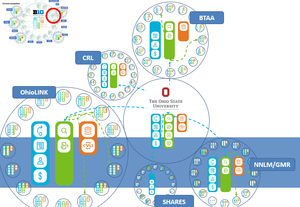I was very taken by Timothy Burke‘s presentation at the first open meeting of the Library of Congress Working Group on Bibliographic Control. What was especially interesting was how he outlined a variety of ways in which he needed to interact with the literature. In his own specialties, he expected to have comprehensive knowledge of what was published. Occasionally he might prospect a new area, wanting to get a sense of its ‘shape’. He might need to understand something of the research area of a student. And so on. This variety of approaches led him to outline a set of capacities that would be useful to him, summarized in the meeting report as follows:
- the ability to recognize clusters of knowledge production (persons and subjects),
- the lineage of publications (i.e., how they exist in chronological relationship to each other),
- the ability to make previously unknown connections among resources,
- the ability to make serendipitous or unforeseen connections among topics,
- identification of the authoritativeness of sources,
- the popularity/amount of use of a resource, and
- the sociology of knowledge, for example the “pedigree” of authors and publishers.
[Users and Uses of Bibliographic Data Meeting – Meetings – (Library of Congress)]
Now, he does not talk about ‘discovery’ or ‘search’; he talks about patterns, relationships, judgements. That said, I was also interested that for his specialist areas he was able to name appropriate Library of Congress Subject Headings.
It seems to me that that phrase “strategic reading” might cover what he is doing quite nicely: his pattern of reading is determined by a particular goal, and will be different depending on the goal. His goals are probably variably well supported by our bibliographic apparatus (and remember he is also the author of the modestly notorious Burn the catalog.)
“Strategic reading” is a phrase used by Alan Renear and Carole Palmer in a recent contribution to Science Magazine: Strategic Reading, Ontologies, and the Future of Scientific Publishing (Science 14 August 2009: 828-832) (behind a paywall), and in the associated news story. Their focus is more on the techniques adopted to do some of what is discussed above, than the patterns themselves.
Scientists have always strived to avoid unnecessary reading. Like all researchers, they use indexing and citations as indicators of relevance, abstracts and literature reviews as surrogates for full papers, and social networks of colleagues and graduate students as personal alerting services. The aim is to move rapidly through the literature to assess and exploit content with as little actual reading as possible. As indexing, recommending, and navigation has become more sophisticated in the online environment, these strategic reading practices have intensified. …
… They sweep through resources, changing search strings, chaining references backward and citations forward, dodging integrator and publisher sites to find open-access copies, continually working to reduce the number of clicks required for access. By note-taking or cutting and pasting, scientists often extract and accumulate bits of specific information, such as findings, equations, protocols, and data.
In this process, rapid judgments are made–such as assessments of relevance, impact, and quality–while search queries are being formulated and refined. (Fig. 3). The goal often seems to be undifferentiated assimilation of information about a domain or a problem at hand, and the online experience may be highly valuable, even though no clear aim is met and no articles to read are located. [Allen H. Renear and Carole L. Palmer. Strategic Reading, Ontologies, and the Future of Scientific Publishing. Science 325, 828 (2009) – behind a paywall]
They go on to refer to the analogy with the remote control proposed by David Nicholas et al in their work on information behaviors. We have become bouncers and flickers, moving horizontally though the literature.
Just as the aim of channel surfing is not to find a program to watch, the goal of literature surfing, is not to find an article to read, but rather to find, assess, and exploit a range of information by scanning portions of many articles. This behavior is common among scientists (9). [Allen H. Renear and Carole L. Palmer. Strategic Reading, Ontologies, and the Future of Scientific Publishing. Science 325, 828 (2009) – behind a paywall]
What types of services are strategic readers most likely to use?
(9) D. Nicholas, P. Huntington, H. R. Jamali, T. Dobrowolski, Inf. Process. Manage. 43, 1085 (2007).



